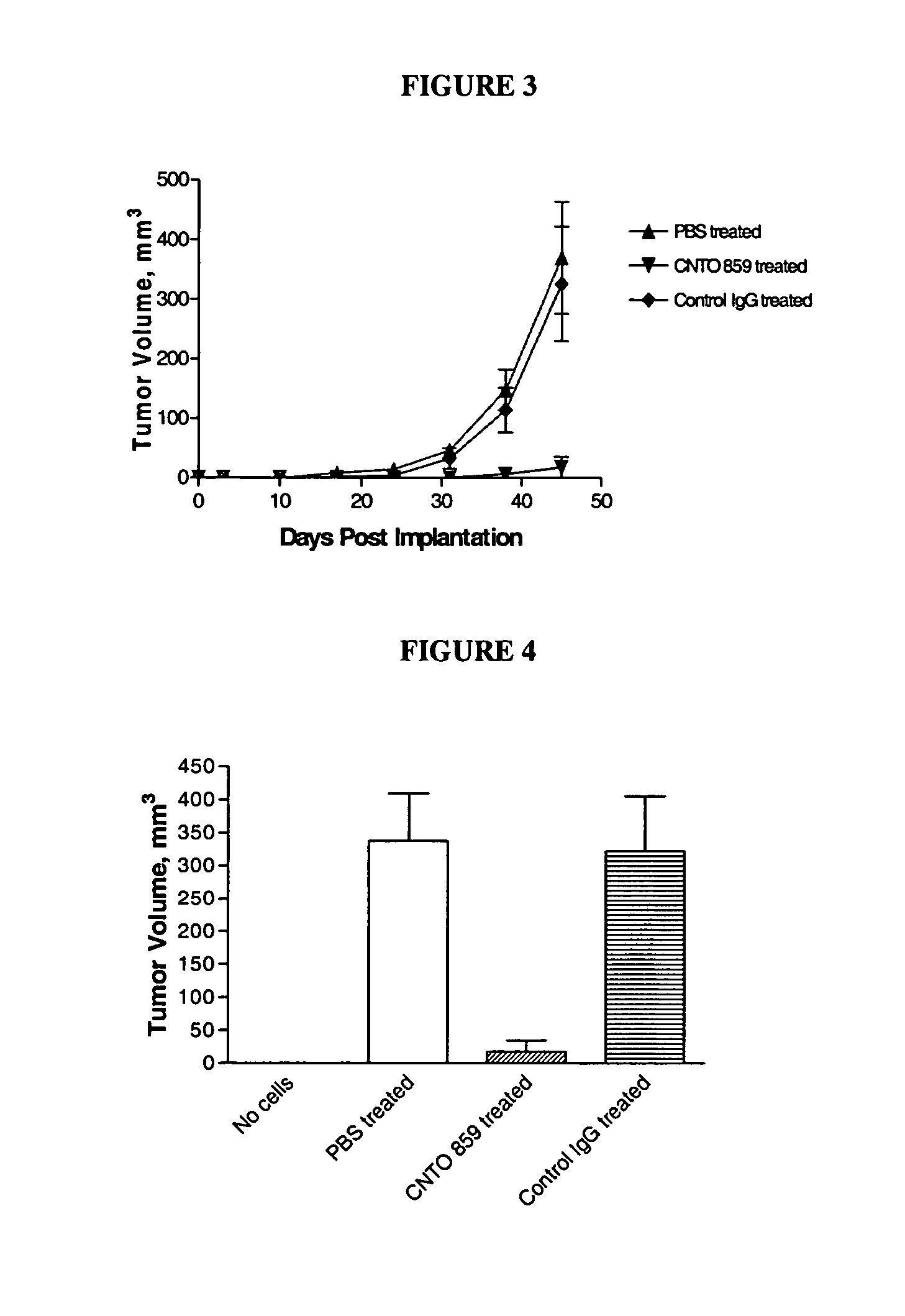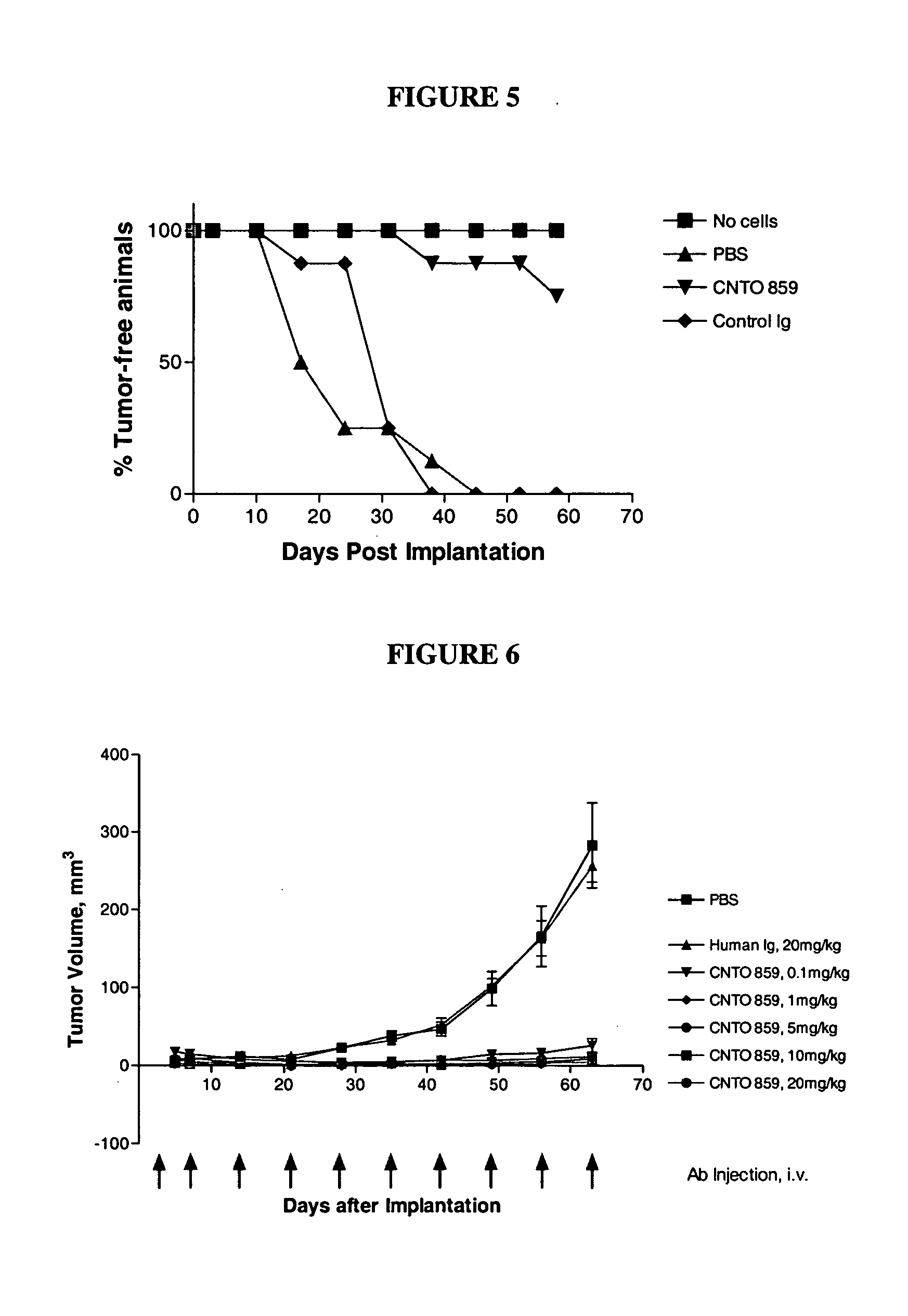Method of inhibiting tumor growth with anti-tissue factor antibodies
- Summary
- Abstract
- Description
- Claims
- Application Information
AI Technical Summary
Benefits of technology
Problems solved by technology
Method used
Image
Examples
example 1
Inhibition of Tumor Growth in Breast Carcinoma Xenografts
This example demonstrates the ability of anti-tissue factor IgG antibody to inhibit tumor growth of MDA-MB-231 breast carcinoma xenografts implanted in nude mice.
Materials and Methods (50) 4-6 week-old female Nude mice (Crl: NU / NU-CD1) from Charles River Laboratories were obtained and acclimated for 10-14 days prior to experimentation. Mice were maintained in the animal facility at Centocor, Inc. in accordance to the National Institutes of Health Guide for the Care and Use of Laboratory Animals.
The human breast carcinoma cell line MDA-MB-231 was obtained from ATCC (Rockville, Md., Catalog #HTB-26). Cells were cultured in DMEM media supplemented with 25 mM HEPES, 10% FBS and 1% LNN at 37° C., 5% CO2. Cells were harvested at log phase growth with trypsin-EDTA and resuspended in sterile HBSS at 5×107 cells / mL.
Antibodies: CNTO 859, CDR grafted TF8-5G9 antibody disclosed in WO96 / 40921, stock concentration 3.75 mg / mL; hIg, Z...
example 2
Effect of Anti-tf Antibody on Human Breast Carcinoma in an Orthotopic Xenograft Model
In this example, an orthotopic tumor growth model using the human breast carcinoma cell line, MDA MB 231, injected into the mammary fat pad of SCID / Beige mice was used to test the anti-tumor effect of CNTO 859. In addition, the effect of variations on the structure of anti-tissue factor antibody were compared: one differing in human class identity CNTO 859 (IgG4) and CNTO 860 (IgG1); and modification of the FcR binding region CNTO 859 designated CNTO 859 ala / ala.
Materials and Methods Four week-old female SCID / Beige mice (C.B.-17 / IcrCrl-scid-bgBR) from Charles River Laboratories were obtained and acclimated for 10-14 days prior to experimentation. Mice were housed 7-8 / cage in filter top cages and supplied with autoclaved food and acidified water containing Bactrum (0.13 mg / mL trimethoprim / 0.66 mg / mL sulfamethoxazole) ad libitum. Animals were identified by individually numbered ear tags placed 5 d...
example 3
Inhibition of Tumor Growth in Pancreatic Adenocarcinoma Xenografts
In this example we demonstrate the effect of an anti-tissue factor antibody on growth inhibition of the pancreatic adenocarcinoma cell line, BxPC-3 grown in the flank of SCID mice. CNTO 859 was dosed once weekly at 10 mg / kg following an initial loading dose of 20 mg / kg. In groups where therapy with CNTO 859 was initiated 1 day, post tumor implantation, growth of BxPC-3 tumors was inhibited by 46.9% (p<0.001). In groups where treatment was initiated at mean tumor volume of 50-100 mm3, tumors were mildly inhibited, but statistical significance was not realized (p=0.6280).
Materials and Methods Six to eight week-old female SCID mice from Charles River Laboratories (Wilmington) were obtained and acclimated for 10-14 days prior to experimentation. Mice were housed 10 / cage in filter top cages, and supplied with autoclaved food and acidified water, containing Bactrum (0.13 mg / mL trimethoprim / 0.66 mg / mL sulfamethoxazo...
PUM
| Property | Measurement | Unit |
|---|---|---|
| Dimensionless property | aaaaa | aaaaa |
| Dimensionless property | aaaaa | aaaaa |
| Adhesion strength | aaaaa | aaaaa |
Abstract
Description
Claims
Application Information
 Login to View More
Login to View More - R&D
- Intellectual Property
- Life Sciences
- Materials
- Tech Scout
- Unparalleled Data Quality
- Higher Quality Content
- 60% Fewer Hallucinations
Browse by: Latest US Patents, China's latest patents, Technical Efficacy Thesaurus, Application Domain, Technology Topic, Popular Technical Reports.
© 2025 PatSnap. All rights reserved.Legal|Privacy policy|Modern Slavery Act Transparency Statement|Sitemap|About US| Contact US: help@patsnap.com



